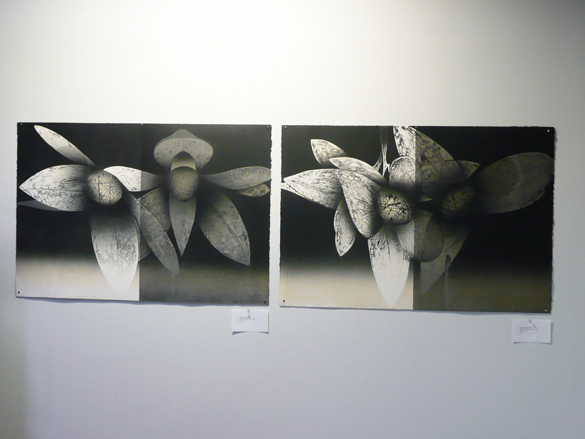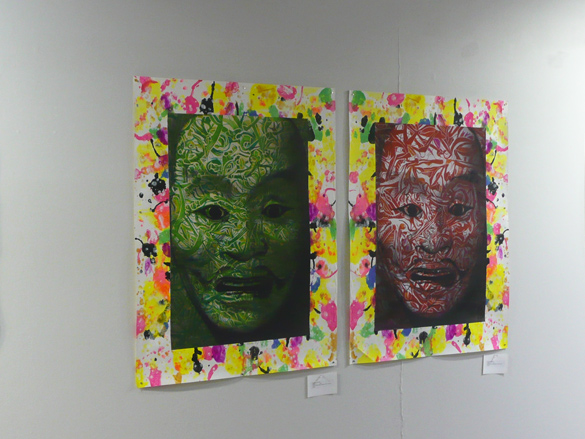exchange exhibition opening


left to right: Ritsuko Takeda, Haruko Cho, Sachiko Kawamura, Prof. Hiroshi Maruyama, Haruki Sakuraba

by Hiroshi Maruyama

by Yusaku Fujiwara

by Isao Kobayashi
Here are a few photos from last week’s opening of the exchange exhibition of works by Japanese printmakers in the Studio Art Gallery at Capilano University. Five of the 17 artists came to Vancouver for this event. It was very well attended, with a gracious welcoming speech from Capilano University President Dr. Kris Bulcroft, who highlighted the benefits of this kind of international art exchange. I was not able to capture all of the artists’ works but I hope these few give some idea of how exciting the exhibition is, well worth a visit while it is up until October 20th.
The works that had been exhibited by the Art Insitute members at the B-Gallery in Japan are displayed downstairs in the studio space. Interestingly, Haruko Cho, one of the artists from Japan, is also the director of the B-Gallery. Ritsuko Takeda, another of the artists, compiled the catalogue for this exchange exhibition.
October 9, 2012 in Art Exhibitions, Other artists, Printmaking by Marja-Leena
Marja-Leena!
Very good photos! Your posting caught well the opening’s feeling. And it is so nice to see that many people came, and of course specifically nice of seeing so many young people.
But 17 artists is a lot. I haven’t counted how many artists we had, but a lot. And in two exhibitions. But you’ll see a picture of Tapani in my blog then! He sent greetings to you!
We had mixed audience in our opening’s last week end. Middle age, older and young people.
I have to mention yet good nibbling food we got after the opening ceremony. All food stuff from right around here, including pihlaja-marmelade (rowan-berries? those trees with bright red berries?) bites. Bytes were without a doubt in presence with Antti Maasalo’s works.
Japanese art has always interested me as well as many Finns, there is something very familiar about it.
Ripsa, kiitos! Most artists are exhibiting two works each and all fit very well in this space with its one long wall, a short wall and the end walls. (We had only one work each in the much smaller B-Gallery in Tokyo.)
I had a quick look at your post, will be back to comment there later. Thanks for the greeting from Tapani Tammenpää though I did not meet him, only his son Juha.
I didn’t know rowan berries are edible! The food at our opening was great too: sushi, cheeses and wine! Too bad we could not visit each other at the respective shows.
Lovely work, and the whole idea of the exchange seems terrific. I especially love Hiroshi Maruyama’s two works – and was so surprised to see that the artist is a man; I wonder why!
Jean, yes, the exchange idea is indeed terrific, and works well with prints.
Maruyama’s work is amongst my favourites, though all the work is lovely as can be expected from Japanese printmakers. Perhaps you are surprised that a male artist does flowers? I have many Japanese friends and learned that usually if the first name ends in the letter o, it is feminine, and an a or i is masculine. I hope I’ve remembered that correctly.
I know Japanese men with names ending -o… I think -a is sometimes a unisex name.
What kind of print is the flower one?
Marly, that’s interesting. I did wonder about the name Taizo, belonging to a Canadian boy (now man!) with a Japanese father, a friend and former classmate of our daughters. That’s why I wrote ‘usually’ to cover some uncertainties.
Good question! Those prints are woodblocks done in the traditional Japanese Ukiyo-e method with some modern adaptation. I hope to do a post on his demonstration of the technique sometime. One of my artist colleagues captured it all on video. When she has edited and uploaded it, I will link to it. In the meantime, anyone interested can view this older post about this very technique.
Oh, yes, I read that post–very interesting how he marks the blocks. And wheat paste! Wasn’t expecting.
Marly, yes. you had mentioned that in the comments. I’m thinking some other readers might also be interested. The technique is so non-toxic that one could do it at home. I’ll admit I haven’t tried it myself.
I’m intrigued by the prints you’ve shown here, and went back to read the prior post on technique — how exciting to have this terrific exchange! Thank you for the glimpse you’ve given us.
Beth, I’m glad you found this interesting. The Japanese method of woodblock printing with watercolours seems to me to be a technique that would suit your style of work – have you tried it?
It looks to have been a wonderful show. I have to admit that of the few you’ve posted my favorites are also the flowers by Professor Maruyama. I will check out the video when it’s available.
Susan, yes, it is an excellent show. I’m sorry I did not get photos of the other very interesting work; by the time I thought of it the gallery was getting crowded.
I loved the flowers particularly. What a wonderful idea this exchange was!
XO
WWW
Wisewebwoman, thanks for adding your voice – we all seem to agree on the flowers and the exchange idea.
I thought of Beth also when I went back and reread the earlier post…
Marly, how well we know our friend Beth….